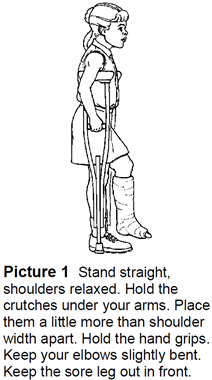Crutch Walking

Crutches may be used to keep weight off a leg or foot while it is healing. Your health care provider will check one of the weight-bearing instructions below:
- Non-Weight-Bearing (NWB) – Do not put any weight on the injured foot or leg.
- Touch-Down Weight-Bearing (TDWB) – The foot may rest on the floor very lightly, but NO weight through the leg.
- Partial Weight-Bearing (PWB) – You may put some weight on the foot.
- Weight-Bearing as Tolerated (WBAT) – You may put as much weight on your leg and foot as you are comfortable with.



- The height of the crutches should be adjusted so there is space for two fingers between your armpit and the crutch pad.
- Your weight should be on the palms of your hands and not on your underarms. Always push down with your hands. Try not to lean on the underarm pieces because this can cause tingling and numbness in your arms or hands (Pictures 1, 2, and 3).
- Make sure you have rubber safety tips on the bottoms of the crutches. The safety tips keep you from slipping. Check the rubber tips every few days. Replace the tips if they show signs of wear.
Stairs With Crutches
When you are going up stairs, lead with your good leg. When you are going down stairs, lead with your crutches, then your sore leg (crutches always stay with the sore leg). This may help you remember: “Up with the Good, Down with the Bad.”
- To go up the stairs: Keep your sore leg and the crutches on the ground. Push down with your hands and hop up onto the step with your good leg. Then bring the sore leg and crutches up on the step (Pictures 4 and 5). Repeat for each step.

- To go down the stairs: Face the stairs. Put the crutches on the step and then your sore leg on the same step. Push down with your hands. Bend your good knee and lower yourself to the next step. Hop down to the step on your good foot (Pictures 6 and 7). Repeat for each step.

Scooting on Stairs
You can “scoot” up or down the stairs on your bottom. For safety have someone help you with your sore leg.
- To “scoot” up the stairs: Turn around to face down the stairs and sit on a lower step. Use your arms and good leg to push yourself up the stairs, one step at a time.
- To “scoot” down the stairs: Sit down facing the stairs, away from the edge of the top step. Scoot forward and use your arms and good leg to lower yourself down the steps, one at a time.
Follow-Up
- It is a good idea for parents to talk to their child’s school and ask if their child can be released from classes 5 minutes early to allow time to get to the next class or the school bus.
- Call your health care provider or the Orthopedic Clinic in Columbus at (614) 722-5175 or in Toledo at (419) 251-2061 to make an appointment.
- If you have questions, call your child‘s physical therapist or nurse.
Crutch Walking (PDF), Somali (PDF), Spanish (PDF)
HH-II-6 4/77, Reviewed 3/22 Copyright 1977, Nationwide Children’s Hospital


